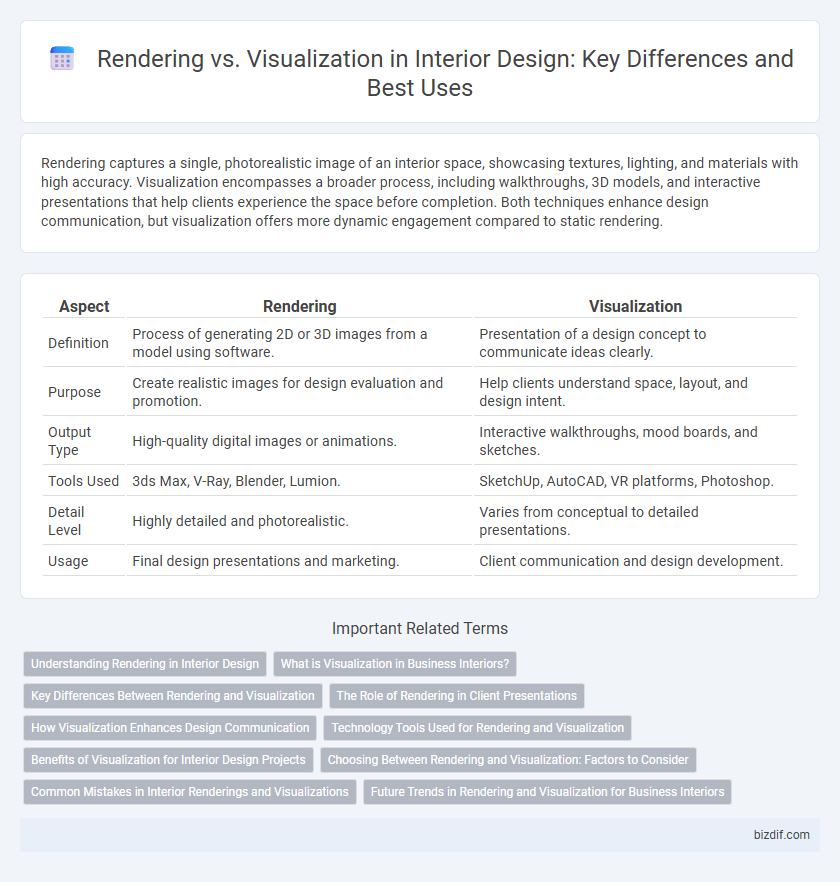Rendering captures a single, photorealistic image of an interior space, showcasing textures, lighting, and materials with high accuracy. Visualization encompasses a broader process, including walkthroughs, 3D models, and interactive presentations that help clients experience the space before completion. Both techniques enhance design communication, but visualization offers more dynamic engagement compared to static rendering.
Table of Comparison
| Aspect | Rendering | Visualization |
|---|---|---|
| Definition | Process of generating 2D or 3D images from a model using software. | Presentation of a design concept to communicate ideas clearly. |
| Purpose | Create realistic images for design evaluation and promotion. | Help clients understand space, layout, and design intent. |
| Output Type | High-quality digital images or animations. | Interactive walkthroughs, mood boards, and sketches. |
| Tools Used | 3ds Max, V-Ray, Blender, Lumion. | SketchUp, AutoCAD, VR platforms, Photoshop. |
| Detail Level | Highly detailed and photorealistic. | Varies from conceptual to detailed presentations. |
| Usage | Final design presentations and marketing. | Client communication and design development. |
Understanding Rendering in Interior Design
Rendering in interior design involves creating photorealistic images from 3D models to accurately represent textures, lighting, and spatial arrangements. This process enables designers and clients to visualize the final look of a space before construction or renovation begins. High-quality rendering enhances decision-making by providing detailed perspectives of materials, colors, and furniture placement within the interior environment.
What is Visualization in Business Interiors?
Visualization in business interiors involves creating detailed digital representations that illustrate layout, lighting, materials, and spatial relationships to help stakeholders understand and evaluate design concepts. This process uses advanced 3D modeling and software tools to produce photorealistic images and walkthroughs, enabling effective communication of design intent and facilitating informed decision-making. It enhances client engagement by providing a clear preview of the final environment, reducing costly revisions during construction.
Key Differences Between Rendering and Visualization
Rendering produces a single high-quality image or animation from 3D models to showcase realistic lighting, textures, and materials in interior design projects. Visualization encompasses the broader process of creating and interacting with 3D models, including real-time walkthroughs, virtual reality experiences, and conceptual presentations. The key difference lies in rendering's focus on photorealistic output, while visualization prioritizes comprehensive spatial understanding and immersive exploration.
The Role of Rendering in Client Presentations
Rendering plays a crucial role in client presentations by transforming conceptual interior designs into photorealistic images that accurately depict materials, lighting, and spatial arrangements. High-quality renderings help clients visualize the final outcome, enabling better decision-making and alignment with design expectations. This process reduces misunderstandings and accelerates project approval by providing a clear and immersive representation of proposed interiors.
How Visualization Enhances Design Communication
Visualization enhances design communication by providing immersive, photorealistic representations of interior spaces, allowing clients and designers to experience the environment before construction begins. This interactive approach bridges the gap between concept and reality, improving stakeholder understanding and decision-making. Advanced visualization techniques, such as 3D walkthroughs and virtual reality, enable precise feedback and refinements, ensuring the final design aligns with client expectations.
Technology Tools Used for Rendering and Visualization
Rendering utilizes advanced software like Autodesk 3ds Max, V-Ray, and Blender to generate photorealistic images through ray tracing and global illumination techniques. Visualization employs real-time engines such as Unreal Engine and Lumion to create immersive, interactive walkthroughs with dynamic lighting and material simulations. Both technologies rely on GPU acceleration and AI-powered denoising to enhance speed and image quality in interior design presentations.
Benefits of Visualization for Interior Design Projects
Visualization in interior design projects offers an immersive experience by providing realistic, three-dimensional representations of spaces that enhance client understanding and decision-making. It enables accurate spatial analysis and material selection, reducing costly alterations during the construction phase. Advanced visualization tools also facilitate seamless communication between designers, clients, and contractors, leading to efficient project workflow and improved outcomes.
Choosing Between Rendering and Visualization: Factors to Consider
Choosing between rendering and visualization depends on project complexity, timeline, and desired realism in interior design presentations. Rendering offers high-quality, photorealistic images ideal for final client approvals, while visualization provides interactive, real-time experiences useful for design exploration and modification. Evaluating the client's needs and project goals ensures the most effective use of these digital tools for conceptualizing interior spaces.
Common Mistakes in Interior Renderings and Visualizations
Common mistakes in interior renderings and visualizations include inaccurate lighting that fails to reflect natural or artificial sources, unrealistic material textures that detract from design authenticity, and poor spatial proportions leading to misinterpretation of room dimensions. Overuse of post-processing effects can create artificial finishes, while neglecting ergonomic furniture arrangements often disrupts functional flow. Ensuring precise color calibration and incorporating detailed architectural elements are essential to achieve photorealistic and effective interior presentations.
Future Trends in Rendering and Visualization for Business Interiors
Future trends in rendering and visualization for business interiors emphasize real-time ray tracing and AI-driven design customization, enabling more accurate and immersive presentations. Integrating virtual reality (VR) and augmented reality (AR) enhances client engagement by allowing interactive exploration of office layouts and materials. Cloud-based rendering platforms improve collaboration and scalability, accelerating project timelines and optimizing decision-making processes.
Rendering vs Visualization Infographic

 bizdif.com
bizdif.com